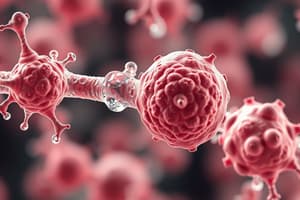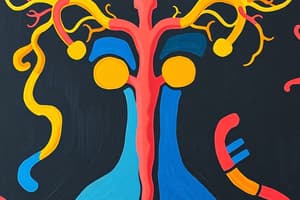Podcast
Questions and Answers
If Müllerian inhibitory hormone is not released during fetal development, what is the likely outcome?
If Müllerian inhibitory hormone is not released during fetal development, what is the likely outcome?
- The fetus will develop ambiguous genitalia.
- The fetus will develop as female, regardless of its chromosomal sex. (correct)
- The fetus will develop as male due to the presence of androgens.
- The fetus will develop testes regardless of its chromosomal sex.
Which of the following statements best describes the role of alpha-fetoprotein in brain sexual differentiation?
Which of the following statements best describes the role of alpha-fetoprotein in brain sexual differentiation?
- It binds to estradiol, preventing it from masculinizing the female brain. (correct)
- It converts testosterone into estradiol in the developing brain.
- It transports testosterone across the blood-brain barrier.
- It directly stimulates the growth of the sexual dimorphic nucleus.
What is the primary outcome of androgen release in the first week post-natal?
What is the primary outcome of androgen release in the first week post-natal?
- Development of the testes (correct)
- Cyclical hormone release in the hypothalamus
- Default female brain development
- Inhibition of the Müllerian ducts.
What determines the size and activity of the sexual dimorphic nucleus (SDN) in rats?
What determines the size and activity of the sexual dimorphic nucleus (SDN) in rats?
What characterizes Turner's syndrome (XO)?
What characterizes Turner's syndrome (XO)?
What is the cause of Congenital Adrenal Hyperplasia (CAH) in XX individuals?
What is the cause of Congenital Adrenal Hyperplasia (CAH) in XX individuals?
What can be concluded about the role of the hypothalamus and amygdala in rat mating behavior?
What can be concluded about the role of the hypothalamus and amygdala in rat mating behavior?
What is a likely outcome of damage to the frontal lobe regarding sexual behavior?
What is a likely outcome of damage to the frontal lobe regarding sexual behavior?
What is the mechanism of the intense reward associated with orgasm?
What is the mechanism of the intense reward associated with orgasm?
What role does oxytocin have in pair bonding?
What role does oxytocin have in pair bonding?
How do male vs female brains typically vary in cognitive abilities?
How do male vs female brains typically vary in cognitive abilities?
What finding supports the claim that women's brains may be more symmetrical than men's?
What finding supports the claim that women's brains may be more symmetrical than men's?
What is the function of pheromones?
What is the function of pheromones?
What function does the enzyme aromatase serve?
What function does the enzyme aromatase serve?
Which hormone is released by both male and female reproductive organs, but in differing proportions?
Which hormone is released by both male and female reproductive organs, but in differing proportions?
What does ventral medial hypothalamic region do in female rats?
What does ventral medial hypothalamic region do in female rats?
The hypothalamus releases hormones in what way?
The hypothalamus releases hormones in what way?
Where does placental and gonadal estrogen bind?
Where does placental and gonadal estrogen bind?
If someone has a lesion to their left DLPFC, what is the likely outcome?
If someone has a lesion to their left DLPFC, what is the likely outcome?
What have tests revealed about women that identify as gay?
What have tests revealed about women that identify as gay?
Flashcards
Genotype
Genotype
The complete set of genes an organism possesses, organized into chromosomes.
Chromosomes
Chromosomes
Structures containing genes; humans have 23 pairs in each somatic cell.
Sex Chromosomes
Sex Chromosomes
Sex chromosomes that determine physical and behavioral sexual characteristics (XX for female, XY for male).
Female Genome
Female Genome
Signup and view all the flashcards
Male Genome
Male Genome
Signup and view all the flashcards
Sex Hormones
Sex Hormones
Signup and view all the flashcards
Androgens
Androgens
Signup and view all the flashcards
Estrogens
Estrogens
Signup and view all the flashcards
Progesterone
Progesterone
Signup and view all the flashcards
Aromatase
Aromatase
Signup and view all the flashcards
Sexual Dimorphic Nucleus
Sexual Dimorphic Nucleus
Signup and view all the flashcards
Alpha Fetoprotein
Alpha Fetoprotein
Signup and view all the flashcards
INAH3
INAH3
Signup and view all the flashcards
Suprachiasmatic Nucleus
Suprachiasmatic Nucleus
Signup and view all the flashcards
Proceptive Behavior
Proceptive Behavior
Signup and view all the flashcards
Lordosis
Lordosis
Signup and view all the flashcards
Amygdala
Amygdala
Signup and view all the flashcards
Dopamine
Dopamine
Signup and view all the flashcards
Mesolimbic Pathway
Mesolimbic Pathway
Signup and view all the flashcards
Oxytocin
Oxytocin
Signup and view all the flashcards
Study Notes
- The lecture covers sex and the brain, referencing Ellison Chapter 10 and Kolb & Whishaw Chapter 12
Chromosomes, Genes, and Sex
- Genotype refers to the complete set of genes an organism possesses
- Genes are organized into chromosomes
- Somatic cells contain 23 pairs of chromosomes, 23 from each parent, totaling 46
- The 23rd pair determines sex and influences physical and behavioral sexual characteristics
- Sex chromosomes are either X or Y
- Females have two X chromosomes (XX), while males have one X and one Y chromosome (XY)
Factors Determining Sex
- Genotype (XX or XY)
- Prenatal action of sex hormones
- Postnatal proportion of sex hormones
MAMAWAWA vs WEARBOH
- Men are men and women are women
- Men are women
- Everyone is influenced by hormones
Sex Hormones
- Androgens (testosterone) and Estrogens (estradiol), along with Progesterone, are gonadal hormones
- These hormones are released in differing proportions by both male and female reproductive organs
- Testosterone can be converted into 5-a-dihydrotestosterone by 5-a-reductase
- Aromatase converts testosterone into 17-B-estradiol
Brain Differences
- The preoptic nucleus in rats is initially the same size in both sexes
- In males, estradiol acts on the nucleus, causing it to grow larger than in females
- This is called the sexual dimorphic nucleus, correlates with testosterone levels
- In both sexes, alpha fetoprotein binds estrogen, rendering it inactive
- Estradiol, converted from testosterone by aromatase in the brain, has a masculinizing effect
- INAH3 is larger in males than in females
- The suprachiasmatic nucleus (SCN) contains more neurons in the male brain
- Gonadal hormones influence the brain throughout life, changes in hormone levels affect behavior
Genetic Mutations and Sexual Identity
- Genotypic and phenotypic sex are usually aligned
- Genetic mutations can lead to ambiguous sexual phenotypes
- Turner's syndrome (XO) results in short stature and lack of sexual development in women
- Congenital adrenal hyperplasia (CAH) causes high androgen levels
- This results in masculinization of XX individuals
- Androgen insensitivity syndrome (AIS) makes individuals unresponsive to androgen, leading to feminization of XY individuals
Gender Differences in Sexual Behavior
- Many animal behaviors vary between sexes
- This is referred to as sexually dimorphic behavior
- Female rats display proceptive behaviors (hopping, darting, ear wiggling) and adopt a lordosis posture when ready to mate
- These behaviors are mediated by the ventromedial hypothalamus, which is rich in estrogen receptors
- The female behaviors prompt the male to mount and mate, mediated by the preoptic area of the hypothalamus
Songbirds and Sexual Behavior
- Sexually dimorphic behaviors are designed to attract mates or warn off rivals
- Male songbirds produce complex songs, while females do not
- Male song comprises characteristic repeating elements
- Humans also show differences in attitudes towards sex, with it being a bigger evolutionary investment for females
Amygdala and Sexual Motivation
- Lesions in the hypothalamus stop mating behavior, but interest in receptive females persists
- Monkeys with hypothalamic lesions do not mate but masturbate while watching receptive females
- Rats with hypothalamic lesions press a bar to access females but do not copulate
- Rats with amygdala lesions show no interest in accessing females but copulate if placed in the same cage
- Hypothalamus mediates sexual behavior
- Amygdala mediates motivation
Frontal Lobe and Sexual Behavior
- Sexual behavior involves thinking, dreaming and other cerebral cortex regions
- Visual imagery about sex activates the visual cortex
- Frontal lobe damage can cause loss of sexual inhibition or libido
- May also lead to erotomania
- Lesions to the left dorsolateral prefrontal cortex (DLPFC) may lead to aggressive sexual behavior
Sexual Reward
- Completing sexual behavior results in reward
- Orgasm causes release of dopamine and relaxation due to oxytocin
- Oxytocin promotes pair bonding
- Oxytocin is structurally linked to endorphins
- Agitation felt from separation may be due to lower oxytocin levels
Cognitive Abilities Between the Sexes
- Testing reveals women excel in verbal fluency
- Men do better in spatial reasoning tests.
- One theory suggests men ranged over larger territories
- Greater spatial abilities might have been advantageous
- Also argued that females developed tools for social communication and were left behind
- The neural basis for these differences may include frontal lobe variations and a larger corpus callosum in women
- This suggests women may be more symmetrical
Other Factors
- Pheromones influence behavior
- Pheromones are chemicals that are not consciously perceived as smells
- These activate the amygdala and hypothalamus
Sexual Orientation
- Studies show gay women have asymmetric brains like straight men in 2008
- Gay men have symmetric brains like straight women
- The amygdala of straight women and gay men connects to brain areas involved in mood, fear, and anxiety
- The amygdala of gay women and straight men connects more to the sensorimotor system and basal ganglia
- Sexual orientation and identity may stem from hypothalamic structures
- The suprachiasmatic nucleus (SCN) contains more neurons in male brains
- SCN is larger in gay men than in heterosexual men
- INAH3 is larger in males but smaller in heterosexual male brains
- Sexual orientation is linked to the X chromosome (Xq28)
- Disturbed interactions between brain development and hormones cause orientation
- Social factors can modulate the expression of the genotype
Studying That Suits You
Use AI to generate personalized quizzes and flashcards to suit your learning preferences.




